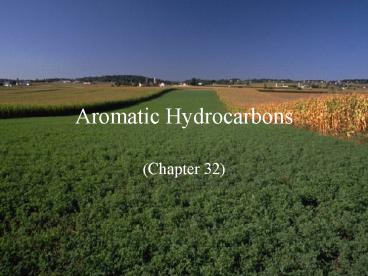Aromatic Hydrocarbons - PowerPoint PPT Presentation
1 / 18
Title:
Aromatic Hydrocarbons
Description:
Aromatic Hydrocarbons (Chapter 32) Aromatic Hydrocarbons. Aroma. Ring of sp2 carbon atoms ... A CH2=CH-C C-CH=CH2. B CH3-C C-C C-CH3. A is ruled out because only ONE ... – PowerPoint PPT presentation
Number of Views:556
Avg rating:3.0/5.0
Title: Aromatic Hydrocarbons
1
Aromatic Hydrocarbons
- (Chapter 32)
2
Aromatic Hydrocarbons
Aroma Ring of sp2 carbon atoms (4n2) ?
delocalized bonding electrons
3
Discovery of the structure of benzene
Molecular Formula C6H6 Structural Formula
?
Possible structure A CH2CH-C?C-CHCH2 B
CH3-C?C-C?C-CH3
A is ruled out because only ONE monosubstituted
chlorobenzene.
4
Discovery of the structure of benzene
Evidence There are THREE disubstituted
isomers of C6H4Cl2. B (CH3-C?C-C?C-CH3
)is ruled out too!
5
Discovery of the structure of benzene
Kekule(1865) Chemist and Dreamer one of
the snakes has seized hold of its own tail .
6
Discovery of the structure of benzene
- Objections to Kekule Benzene
- A 4th isomer of C6H4Cl2
- Surprising stability of benzene
- All the C-C bonds are the same length
7
Discovery of the structure of benzene
- Delocalization of Bonding Electrons
- 3e- in sp2 hybrids form normal covalent bonds
- 4th e-, one from each carbon atoms are free to
visit - all the atoms on the ring (delocalized bonding
- electrons)
8
Stability of the Benzene Ring
9
Reactions of Benzene
- No reaction with Br2/dark
- No reaction with MnO4-/H
Although benzene is unsaturated, it is resistant
to oxidation and addition reaction because of the
energy of delocalization is lost in such reaction.
10
Electrophilic Aromatic Substitution
- General Mechanism
- Formation of Electrophile, E
- Attack of E on ? electron cloud of benzene
- Loss of a proton
H
r.d.s
-H
E
E
E
11
Benzenonium ion
12
Electrophilic Aromatic Substitution
13
Electrophilic Aromatic Substitution
Reaction Reagent Catalyst Product E or E
Halogenation X2(Cl,Br) FeX3 ArCl, ArBr X
Nitration HNO3 H2SO4 ArNO2 NO2
Sulphonation H2SO4 None ArSO3H SO3
Alkylation RX(Cl,Br) AlX3 Ar-R R
14
Formation of E
- X2 FeX3 gt X FeX4-
- H2SO4 HONO2 gt HSO4- H2ONO2 gt
- H2O
NO2 - 2H2SO4 gt HSO4- H3O SO3
- RX AlX3 gt R AlX4-
15
Reversible nature of sulphonation
SO3H
c.H2SO4 80oC, reflux
Benzenesulphonic acid
SO3H
H2O, H2SO4 Tgt100oC
H2SO4
16
(No Transcript)
17
Oxidation of alkylbenzene
COOH
COO-
CH3
KMnO4/OH- heat
H3O
KMnO4/OH- is better than KMnO4/H As C6H5COO-
acts as a solvent that mix C6H5CH3 and MnO4-
18
Oxidation of alkylbenzene
Oxidation takes place at first by the
abstraction of a phenylmethyl hydrogen by the
O.A., once take place, oxidation continues until
a carboxyl group is left.
COOH
CH2CH2CH2R
CR3
No reaction (no H on C)































